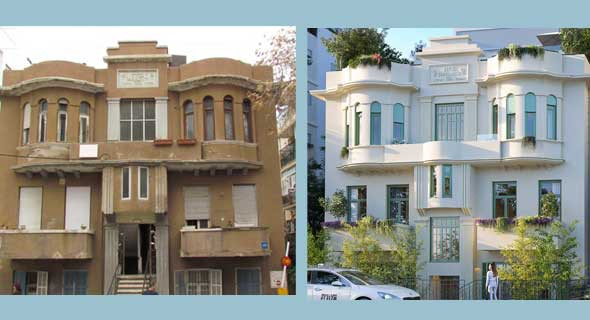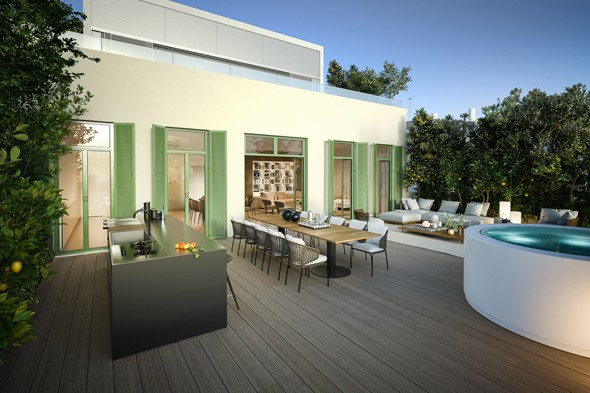Ronen Niv , calcalist.co.il.
After capturing the local luxury apartment market and being a status symbol of economic success for the Israelis, the high-rise in Tel Aviv has recently given way to a new standard of luxury. No longer lobby, doorman, aquariums, mirrors and other landscaping - the contemporary trend tends towards the "old-fashioned" direction: buildings for preservation throughout the city, which have been extensively refurbished and restored to prestigious property of historic and architectural value, are soaring.
According to local municipality data, there are about 2,500 preservation buildings in Tel Aviv, of which about 400 are defined as strict preservation structures. Contrary to what one might expect in an era of urban renewal and demolition and rebuilding, it is precisely the preservation structures that do not leave much room for change to attract the best investors in real estate investment.
Pagoda House, one of the most expensive private houses in the city, is a prime example of one of the city's designated preservation buildings. The building was built in 1924 in accordance with the eclectic style that then dominated the urban landscape, and lies in King Albert Square, between Nachmani and Montefiore Streets. The name of the building was given due to the impressive roof mentioned by a Japanese pagoda, and it entered public consciousness in 1935 precisely thanks to an elevator, which was the first in the city to be installed in a residential building and attracted a large curious crowd.
Over the next few decades, the structure underwent many incarnations and changed its purpose many times. It was purchased in 1997 by Swedish-Jewish businessman Robert Weil for about $ 5.5 million, and in the early 2000s, restoration work began under strict conservation conditions.
Another of the city's largest conservation and construction projects, which produces a successful combination of old and new, was done in the nail house, located at the junction of Ahad Ha'am and Nahmani Streets. The roots of the building lie in the fourth decade of the last century and its designations have changed from residential to office and vice versa. In 2007, the building was purchased by Lennox Investment, as part of the 5,000-square-foot Lennox complex, which includes, alongside the original building, two new buildings, with the adjacent water tower also renovated. The complex, which was occupied in 2015, has 23 apartments. Luxury, when according to publications Ruth Cheshin, founder of the Jerusalem Foundation, purchased a penthouse in the complex for NIS 47 million in 2018.
"The main goal for us was to restore the building to its original purpose, and to preserve a residential project that showcases and respects the city's heritage," says Ronnie Bezzio, director of Blanox Investment. "Renovating a building that is set up for strict preservation is fundamentally different from work on a building that is grounded, a matter that is also reflected in the choice of materials and methods. The project was carried out with the municipality and the results achieved were excellent."
"Restoring the building to its greatest"
To return to the present, the focus on luxury condominiums in strict preservation buildings is now directed to the one on Pinsker Street 19. The building is located in one of the white-walled buffer zone areas, declared by UNESCO in 2003 as a World Heritage Site and boasts a long history.
The building was built in 1928 by Nahum Neuman, a Romanian, who was a force in the customs business. The renowned architect Arie Streimer was responsible for the design of the project, and, like the eclectic-style buildings that set the tone in Tel Aviv of the era, the skeleton was built in silicate blocks of sand and lime-plaster with a rugged texture, and it has a decoration that is attached together to a gilded facade, giving it a fancy appearance.
According to conservation architect Anna Schiffman, editor of the building's documentation portfolio, "The investment is much more visible in the construction stages. Not only can the artwork that accompanied the work on the project be identified, but also the desire to build a building that will resonate."
Indeed, since its completion, the building at Pinker 19 has acquired a reputation as one of the most impressive in the city. As part of the narrative that characterizes many of the buildings for preservation, it has also undergone a variety of changes over the years: both in the building itself and in the owner's section, until in 2016, the property acquired the city building company.
"I was exposed to the building at the beginning of the decade," recalls Dudu McCase, the company's head, "and immediately caught my eye. For years, I kept track of his history, and found that the potential of this structure was far from being realized. Entrepreneurs didn't really know how to handle the complexity of the building and flinched from the stringent conservation requirements of "So when we bought the property, I was very excited. I pledged to restore the building to its size, as befits one of the most beautiful buildings in Tel Aviv."
 The building at Pinsker 19 today, and at the end of the project. “The Works Require Creative Solutions “Photography and Imaging: Courtesy of City Building, Alex Lubimov
The building at Pinsker 19 today, and at the end of the project. “The Works Require Creative Solutions “Photography and Imaging: Courtesy of City Building, Alex Lubimov
Building with Discovery
The transition from a romantic vision to a practical stripe requires the city's building to undergo a complex renovation and restoration process. "We took the original three-story building and added a modern five-story building to the back of the building in a way that is not visible to pedestrians on the street," says engineer Noam Richter, also one of the city's leaders. "The conservation work enhances the beauty of the original structure, so that no bystander remains indifferent to it."
"The work in a strict conservation preserve structure creates limited leeway. “Explains Yiftach Arad, the project's conservation architect. "Such a building has strict guidelines and boundaries that must not be deviated from, which requires creative solutions and out-of-the-box thinking. As part of the work process, a breach dialogue was also created with the City Conservation Department. The key challenge was to restore the feel of a building built in the 1920s and produce A full cultural envelope of the time, while also corresponding with the spirit of the time and connecting the old and the modern, in a way that one would not overshadow the other.
"In the work process, we went back to the original language in which the property was built, but also provided our own interpretation. For example, we made sure that the new side windows in the building were in the same proportions as the existing windows, and that the external shutters would resemble those in the original building. The connection between the hallway and the stairwell required interaction, And in-depth thought of what to bring from here and what to pull away, all to form a balanced mix. We created a building that wraps around that aura of mystery. To understand it in depth requires decryption and discovery. This is the way to connect to the structure, and when that happens, you can't ignore it. "
 His uncle (Case) and Noam Richter. “People want to live in a building with character, with story “Photo: Courtesy of the city building
His uncle (Case) and Noam Richter. “People want to live in a building with character, with story “Photo: Courtesy of the city building
Green preservation masterpiece
Another line provided by the reconstructed building lies in the environmental aspect. "Pinsker 19 is an exceptional structure as it is the first privately owned city in the city to undergo a regulated process of green preservation and renovation, in accordance with the new procedure of the Conservation Department," the municipality said. "The project constitutes a pilot in terms of the Department of Conservation, an exemplary example of conservation and green renovation."
"The rationale is to allow tenants to enjoy a high quality of life while protecting the environment," adds architect Nirit Amir, VP of Business Development at ESD Environmental Development and Sustainability, who accompanied the venture. "Because green construction and stringent conservation do not always go hand in hand, and sometimes even in directions In contrast, comprehensive systemic vision, collaboration, and synchronization are required among all project partners. The renovated building includes advanced water and drainage infrastructure and glazing and shading systems, with the work process involving the use of recycled materials and green materials, assimilating systems that consume as much electricity and energy as possible, and help create thermal and acoustic insulation. A great deal of thought has also been invested with regard to the waste system and even how the spaces are arranged within the apartments. "
Go up to the penthouse
And what prices do you ask? Well, the highlight of the building at Pinsker 19 is the upscale penthouse apartment - a 350 sqm luxury apartment with about 200 sqm of roof space - and a NIS 50 million tag. Designer Daniel Hasson was responsible for the interior design of the penthouse, with the arsenal of amenities for future tenants including, among other things, a pool, gym and hot tub, high ceilings, an indoor elevator between the floors and no less than six parking spaces in the underground car park.
 Penthouse 19. In the arsenal of treats: pool, gym, high ceilings and hot tub Imaging: Alex Lubimov
Penthouse 19. In the arsenal of treats: pool, gym, high ceilings and hot tub Imaging: Alex Lubimov



